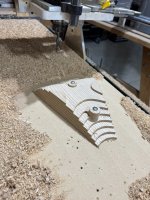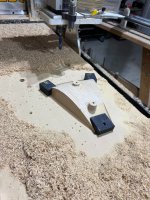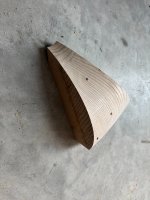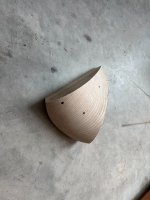I fabricated one "petal" today with some of the extras I screwed up along the way, and amazingly things seem to fit and work as they are supposed to. I need more clamps.
Attachments
looks amazing, if you have cnc possibilities, why not 🙂 must be very heavy though... but that unique looks is worth it I suppose.
has anyone tried wooden filament for these waveguides?
has anyone tried wooden filament for these waveguides?
Would you mind to show your measurements? That would be great.Just measured the Rosso with the small waveguide. Unfortunately -as expected- with such small device without loading not useable below 1300hz xo. Had some hope it does not need much loading. So....next project idea.
Mabat: the Tritonia box sim is only tweeter active I assume?
Why is the combination not usable below 1300 Hz? Distortion? Or drop of response? The latter might not be problem in an active design.
I think the wood filament might be tricky to print due to clogs you may need a bigger nozzle , and the % of wood are still low , I would stick to the cheap old pla my petals weight 150g each and are solidlooks amazing, if you have cnc possibilities, why not 🙂 must be very heavy though... but that unique looks is worth it I suppose.
has anyone tried wooden filament for these waveguides?
Sorry I can not. It was not worth saving it. Dropped below 1300hz and rapidly increasing distortion. Definetively needs loading to get lower XO. Just mark it as another failed experiment (although theese are also important to learn...)Would you mind to show your measurements? That would be great.
Why is the combination not usable below 1300 Hz? Distortion? Or drop of response? The latter might not be problem in an active design.
I fabricated one "petal" today with some of the extras I screwed up along the way, and amazingly things seem to fit and work as they are supposed to. I need more clamps.
Really smart approach with the CNC there. I've been trying to formulate a plan of attack for machining the A460, but your process seems really well thought out.
@galucha it took a lot of thinking and tinkering but I figured out a method that worked well - I basically used two 1/4” holes in the petals to locate the piece on the spoil board, then I actually put brass threaded inserts into the spoil board so I could bolt the piece down to the CNC through the 1/4” registers with a 1/4-20 bolt. Because I was flip milling and laminating two different pieces it was the best way to ensure I was in the ballpark for alignment and centering.
I would tend to think that just about any 1" driver should do fine. If I should pick one, probably the B&C DH450.What driver would you recommend with the new tritonia M waveguide and what woofer/s to pair it with?
Woofer should be as clean as possible as high as possible, both 10" and 12" should do.
I can imagine such speakers doing wonderful job especially for home cinema and multichannel in general.
Last edited:
Just to know i intend to use the bms4554 with the extender, I will like to use a 15 inch , i have simulated the box as seen from the documents the BMS can be crossed at 550hz to match the directivity what do you think ?
It should be capable of 550 Hz, IMO, for home setup. It may not be necessary though, I'd wait for the actual measurements. Also the real directivity of a transducer in an enclosure can be quite different from theoretical considerations.
yes you are right need to see the directivity on the baffle and match it, things could be unexpected, they would make a killer 2 way sistem for home use.
Yes, it's a normalized response of the WG alone.Mabat: the Tritonia box sim is only tweeter active I assume?
Unfortunately -as expected- with such small device without loading not useable below 1300hz xo.
I am not experienced with compression drivers at all, but somehow there seems to be missing a way of determining the lower limit of driver/horn combinations.It should be capable of 550 Hz, IMO, for home setup.
How can a small (44mm) driver go down to 550Hz and a considerably bigger one (65mm) cannot even play one full octave higher?
In the Dutch&Dutch 8c a 26mm dome plays in a small waveguide down to 1250Hz! And the result is not too bad either.
This seems rather odd to me even with the different size of the "horns" that are here at play. After all compression drivers use this construction to get a very high output (with low distortion) in the first place.
What distortion (at 90dB/100 dB) would be acceptable at the XO for hifi/home? Is there a consensus? I would be interested mainly in an active solution.
The long adapter(s) for BMS drivers use a substantial impedance lift at the bottom. It's a very different device than a compression driver virtually without any support. Remember that excursion in these drivers needs always be kept very small.How can a small (44mm) driver go down to 550Hz and a considerably bigger one (65mm) cannot even play one full octave higher?
- For any particular device (a horn+CD combination), below some frequency the distortion just starts to rise rapidly. To me, this is simply the limit.
Last edited:
I finally got around to printing Joseph Crowe's open back cup for the 65cdnt compression driver and im testing it out - It has made for a big upgrade I think highly recommended.
Opened up the sound stage without compromising the imagining. And it's made my speakers proper diople / open baffle instead of closed / open baffle. Seems more fitting.
Opened up the sound stage without compromising the imagining. And it's made my speakers proper diople / open baffle instead of closed / open baffle. Seems more fitting.
That's interesting, good to know. So there's no noticeable degradation in any attribute of the sound? I once tried to measure something similar, but wasn't pleased with the results so I didn't try to actually listen. So maybe the change of the radiation pattern per se is so significant that it overweights the rest. It would be interesting to see polar data.
yeah he has two versions an open and closed version (both included) - I have not got round to measuring it yet and probably won't do so until i have the ATH horn on the front of it as well but currently it's just on my old horn i am replacing and i feel like it is an improvement and more than i expected it to be.
its made a huge improvement to off axis listening too as just i think the extra rear radiation is making the horns less directional filling the room better for non serious listening.
its made a huge improvement to off axis listening too as just i think the extra rear radiation is making the horns less directional filling the room better for non serious listening.
- Home
- Loudspeakers
- Multi-Way
- Acoustic Horn Design – The Easy Way (Ath4)




